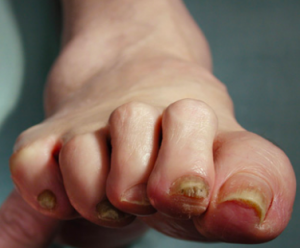 Like
the name describes, claw toes are fixed in a position that resembles a claw or a hook. This means that at the ball of your foot, the toe
starts pointing upwards away from the ground and then starts bending downwards until the tip of the toe is touching the ground, or close to
it. Claw toes often affect multiple toes and both feet, though not always. Claw toes can be flexible or rigid,
and often progress from being relatively flexible and mobile to being stiff and rigid as the contractions at the toe joints progress. If
you’re able to straighten your toes by pushing on them with your hands, they are flexible. If your toes are stiff and cannot change
position, they are rigid. Medically speaking, both of the toe joints (proximal interphalangeal and distal interphalangeal joints) are
flexed to resemble a claw. The joint at the ball of the foot (metatarsophalangeal joint) is extended.
Like
the name describes, claw toes are fixed in a position that resembles a claw or a hook. This means that at the ball of your foot, the toe
starts pointing upwards away from the ground and then starts bending downwards until the tip of the toe is touching the ground, or close to
it. Claw toes often affect multiple toes and both feet, though not always. Claw toes can be flexible or rigid,
and often progress from being relatively flexible and mobile to being stiff and rigid as the contractions at the toe joints progress. If
you’re able to straighten your toes by pushing on them with your hands, they are flexible. If your toes are stiff and cannot change
position, they are rigid. Medically speaking, both of the toe joints (proximal interphalangeal and distal interphalangeal joints) are
flexed to resemble a claw. The joint at the ball of the foot (metatarsophalangeal joint) is extended.
See Anatomy below to help understand the layout of the toes and joints.
Aside from your big toe (medically known as your hallux), each of the lesser four toes are comprised of 3 bones. Each of these bones is called a phalanx, or phalanges as a plural. These are differentiated in name by their location:
Between two phalanges is a joint that connects them. These are called the interphalangeal joints. The joint that connects the proximal phalanx and your long metatarsal bone at the ball of your foot is called the metatarsophalangeal joint. So the 3 joints are:
Ultimately, it is the tightness and contracture of tendons and ligaments that keep the toes in a clawed position and cause them to gradually lose flexibility and movement. The longer the toes remain in this position, the more the surrounding tissues and ligaments in the feet adapt to it and the more fixed it becomes. Wearing tight-fitting shoes on a regular basis that squeeze your feet and curl your toes are often the first element that keeps your toes in a clawed position and trigger the surrounding structures to start contracting. Diabetes, arthritis, trauma, excessive inflammation and alcoholism also are culprits that may trigger the clawing of the toes. The process behind diabetes and alcoholism is resulting nerve damage that weakens the muscles of the foot, leading to the clawing of the toes. Various neurological conditions can also cause weaken the foot muscles.

While some claw toes may remain asymptomatic, claw toes can cause great pain and discomfort. As the clawing becomes more pronounced, the toes begin to rub against the top and bottom of shoes at the tip of the toe. The is painful and can cause corns and callus to develop, which can increase pain and further decrease the already limited space available in the toebox of the shoe. Symptoms are typically worse in rigid claw toes because they lack the ability to move or be manipulated.
Treating claw toes early while they are still flexible is a key to obtaining successful outcomes using conservative methods. Here, the appropriate use of strapping tape or a splint may help correct the position of the toes. Properly fitted shoes with a deeper toe box are recommended to discourage clawing. We’ll recommend the best everyday shoes for your foot type and symptoms, and we have an extensive range of splints available in the clinic. Specific stretching and strengthening exercises often form the cornerstone of treatment and will be outlined by your podiatrist, specific to your symptoms and level of flexibility in the toes.Prescription orthotics may be used to decrease pressure and reduce biomechanical factors contributing to the clawing. Only as a very last resort with rigid claw toes should you consider surgery. Because claw toes are often associated with bunions and other alignment problems, your Podiatrist will advise you on the best way to address the entire foot and any other issues you may be experiencing. Hammertoes are a similar foot deformity that affects the joints slightly differently. To see if you have hammertoes, click here.

If you’re unsure whether you should wear walking or running shoes when exercising, this article is for you.
We explain the differences between walking and running shoes and how to determine which one is best for your feet. When it comes to buying a new pair of shoes, most people walk into a store expecting to just “find something comfy.” Then, suddenly, you’re asked: Are you looking for
walking shoes or running shoes? And that’s where the confusion begins. Because for many people, the answer isn’t that simple.
You could walk a lot – to work, around the block, chasing after the kids, or while catching up with friends. You could have also just joined
a gym or registered for the Couch to 5km. Or you could be a walker who just wants the option to go for a run if the mood strikes. So, which
shoe do you pick?

Discover why foot health is so important as we age and how Perform Podiatry supports seniors in staying mobile, independent, and pain-free. From diabetic care to personalised treatment plans, we’re here to help keep your feet happy and healthy, every step of the way.

Discover how Class IV Laser Therapy at Perform Podiatry offers powerful, drug-free relief for foot and ankle pain. Backed by science, this advanced treatment helps you heal faster and move better, without the need for surgery or medication.
Keeping your family on their feet and helping them to walk, run, play and exceed their goals is why we love getting up in the morning.
Ground Floor, One Health Building
122 Remuera Rd, Remuera
Auckland 1050, New Zealand
| MON - FRI | 7:30am – 6:30pm |
| SAT | 8:30am – 4:30pm |
| SUN | Some availability |
Make an Appointment
Online Schedule
Our virtual receptionist is available 24/7 to help with general questions, booking requests, and clinic information, even when our team is busy, or it's after hours.
Whether you're calling us or using our website, you'll get fast assistance any time of day. And if your query needs a personal touch, a member of our team will follow up as soon as possible.